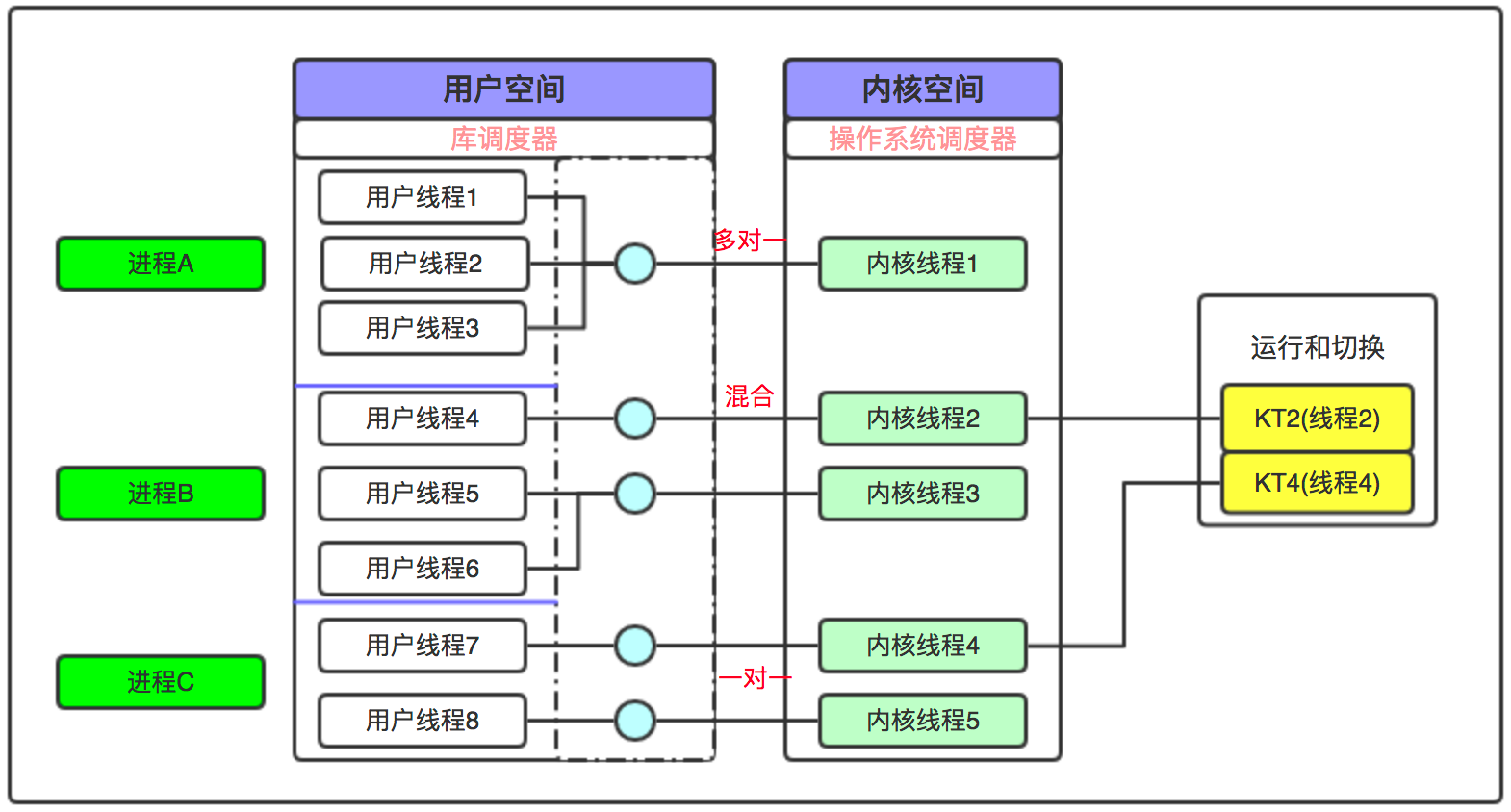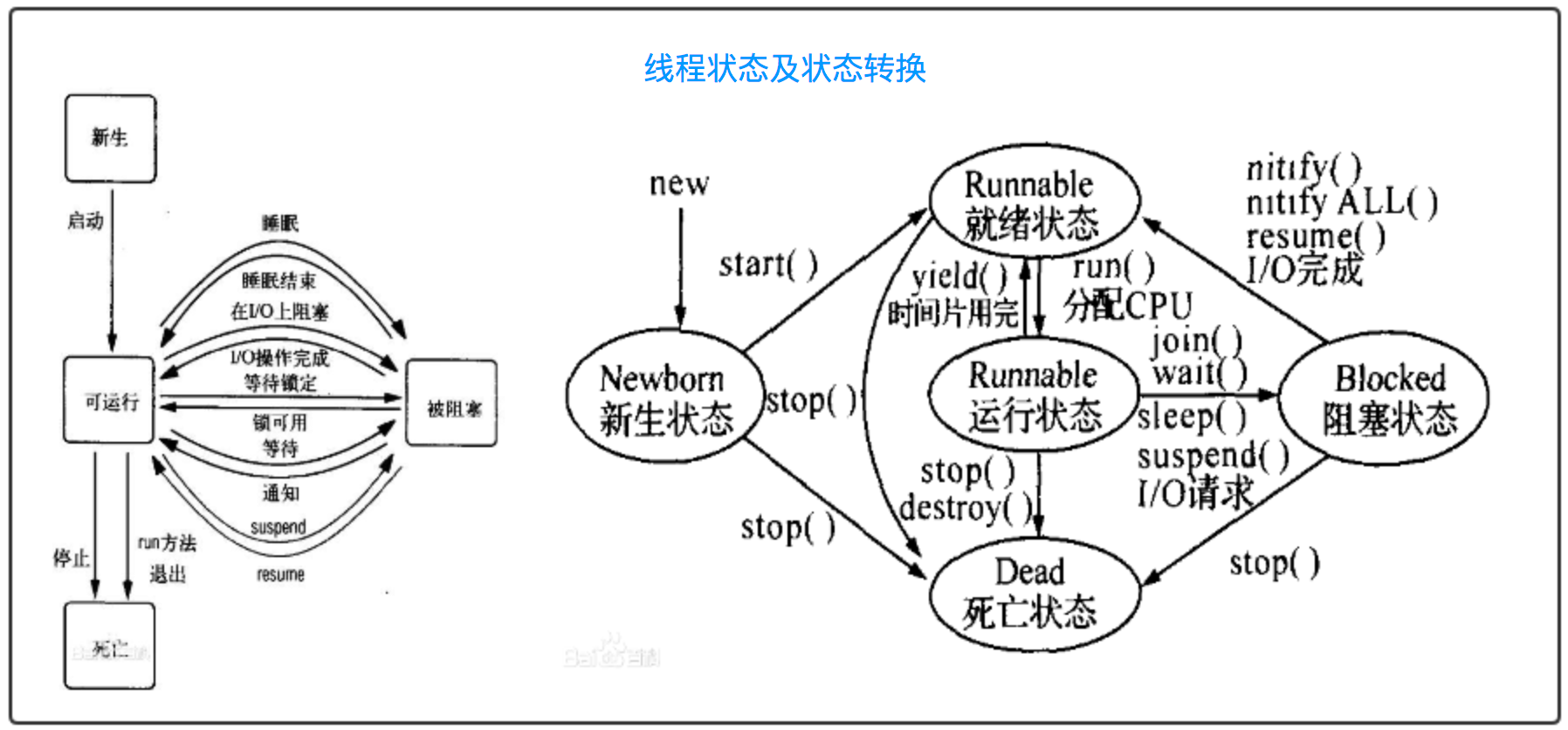python(十一)、线程
一、基本概念
进程是资源分配的基本单位,而线程则是CPU调度和分派的基本单位。系统需要执行创建进程、撤销进程和进程切换等任务,但创建进程开销大限制了并发的提高。因此,成百上千个进程会造成内存浪费,并且频繁切换导致每个进程执行(时间变短)效率降低。因此有了线程的概念。
引入进程的目的是为了使多个程序并发执行,以改善资源利用率、提高系统吞吐量;引入线程的目的则是为了减少程序并发执行时造成的时空开销。即线程既能降低系统资源频繁切换,又能满足进程这种多任务并发异步执行的功能。
线程和进程关系:
1.一个进程可以有多个线程,但至少要有一个线程;一个线程只能在一个进程的地址空间内活动。
2.资源分配给进程,同一进程的所有线程共享该进程内的所有资源。
3.处理机分配给线程,真正在处理机上运行的是线程。
4.线程在执行过程中需要协作同步。不同进程的线程要利用消息通信的办法实现同步。
5.由于线程拥有较少的资源,但又具有传统进程的许多特性,因此线程可被称为轻型进程(light weight process, LWP),传统进程相对称为重型进程(heavy weight process, HWP)。
6.一个线程可以创建和撤销另一个线程
线程优点:易于调度;提高并发量;开销少;能够充分发挥多处理器的功能。
线程模型:和进程一样,包括TCB(Thread Controller Block 线程控制块)、程序和数据。Thread结构包括线程标识符、调度状态信息、核心栈指针、用户栈指针及私有存储区等。
内核级线程和用户级线程:
- 内核级线程(Kernel Supported threads,KST):内核控制线程的创建、撤销和切换,并为每个内核级线程创建TCB,从而感知其存在。内核级线程的优点是:1.在多处理器上,内核可以调用同一进程中的多个线程同时工作;2.如果一个进程中的某个线程阻塞,其他线程仍然可以继续运行。其缺点是:由于线程由CPU调度和分派,用户态线程要经由操作系统进入内核,用户态不同进程的多个线程进行切换时,都要进入内核再进行切换,切换代价较大。
- 用户级线程(User Level Threads,ULT):开放给程序员的、可以通过线程库(如python的Threading.py)创建的线程。用户级线程只存在于用户空间,内核并不能看到用户线程,并且内核资源的分配仍然是按照进程进行分配的;各个用户线程只能在进程内进行资源竞争。用户级线程的优点是:1.同进程内线程切换不需要转换到内核空间,节省了内核空间;2.线程调度算法可以是进程内专用,由用户程序进行指定;3.用户级线程实现和操作系统无关。其缺点是:1.如果系统调用同一进程中某个线程时阻塞,整个进程阻塞;2.一个进程只能在一个cpu上获得执行。
- 用户级线程和内核级线程有着一对一、一对多和混合型的映射关系,具体映射关系由操作系统来决定。
线程状态:线程的状态和进程类似。运行状态:线程在CPU上执行;就绪状态:具备运行条件,一旦分配到CPU就可以立即执行;阻塞状态:线程在等待某个条件的发生从而转为就绪状态。

其它有关线程的概念都可以参考进程有关概念。
二、python线程模块
threading是Python中内置的线程模块,能够实现用户级线程的管理。在Cpython中,python中的一个线程对应c语言中的一个线程。
1.线程创建
线程创建可以通过函数或者子类的方式实现。The Thread class represents an activity that is run in a separate thread of control. There are two ways to specify the activity: by passing a callable object to the constructor, or by overriding the run() method in a subclass. No other methods (except for the constructor) should be overridden in a subclass. In other words, only override the __init__() and run() methods of this class。
from threading import Thread
def desc(step):
global num
for i in range(step):
# print("desc-----: ", num)
num -= 1
print("----------num------------", num)
def add(step):
global num
for i in range(step):
# print("add: ", num)
num += 1
print("----------num------------", num)
if __name__ == '__main__':
num = 0 # 由于共享进程资源,num被子线程共享
step = 1000 # 也可以作为参数传进去来共享变量,而进程必须用队列或者管道
p1 = Thread(target=desc, args=(step, ))
p2 = Thread(target=add, args=(step, ))
p1.start()
p2.start()
p1.join()
p2.join()
print(num)
以子类继承的方式重现上述逻辑。
from threading import Thread class Desc(Thread):
def __init__(self, step):
super().__init__()
self.step = step
def run(self):
global num
for i in range(self.step):
print("desc-----: ", num)
num -= 1 class Add(Thread):
def __init__(self, step):
super().__init__()
self.step = step
def run(self):
global num
for i in range(self.step):
print("add: ", num)
num += 1
if __name__ == '__main__':
num = 0
step = 1000000
p1 = Desc(step)
p2 = Add(step)
p1.start()
p2.start()
p1.join()
p2.join()
print(num)
错误示例在于将共享变量赋给对象属性后,对对象属性进行了自增(自减运算)而没有操作共享变量num。
from threading import Thread class Desc(Thread):
def __init__(self, step):
super().__init__()
self.step = step
self.num = num
def run(self):
for i in range(self.step):
print("desc-----: ", self.num)
self.num -= 1
print("----------num------------", self.num) class Add(Thread):
def __init__(self, step):
super().__init__()
self.step = step
self.num = num
def run(self):
for i in range(self.step):
print("add: ", self.num)
self.num += 1
print("----------num------------", self.num)
if __name__ == '__main__':
num = 0
step = 1000
p1 = Desc(step)
p2 = Add(step)
p1.start()
p2.start()
p1.join()
p2.join()
print(num)
错误示例
一些线程自带的函数。
from threading import Thread
from threading import (active_count, current_thread, get_ident, enumerate, main_thread)
import time
class Example(Thread):
def __init__(self):
super().__init__()
def run(self):
print("current_thread: ", current_thread()) # 当前线程标识符
print("get_ident: ", get_ident()) # 当前线程
time.sleep(3)
print("-------------------------------------------------") if __name__ == '__main__':
p1 = Example()
p1.start()
# p1.setDaemon(True) # 守护线程,主线程结束子线程如果没结束就直接被kill掉
print("active_count: ", active_count()) # 活跃线程数:2
print("enumerate: ", enumerate()) # 当前进程内活跃的线程对象
p1.join() # 主线程等待子线程结束再结束/不写时主线程结束,子线程继续执行
print("active_count: ", active_count()) # 活跃线程数:1 - 主线程
print("current_thread: ", current_thread()) # 当前线程标识符
print("get_ident: ", get_ident()) # 当前线程
print("main_thread: ", main_thread()) # 主线程对象
2.全局解释锁GIL
如果将上面的step设置一个非常大的值,那么num值就有各种结果。这里(解释器Cpython)就要说到全局解释锁GIL (Global interpreter Lock)。它有两个特点:
1.设计之初为了追求简单,会在Cpython上加一把全局锁,能够控制多线程对同一资源的访问。但后来导致的问题是,在同一时刻只有一个线程在一个CPU上执行,也即多个线程无法利用多个CPU。
2.python会按照一定字节码数量(比如1000行字节码)和一定时间间隔(比如15毫秒)主动释放GIL锁。多个线程此时可以争抢GIL锁。这破坏了全局锁的初衷(限制多线程的资源访问,保证数据的准确性),导致GIL锁变得很鸡肋。
3.python会在遇到IO操作时会主动释放GIL。因此python多线程在做I/O操作时任务时(如爬虫)会具有优势。
因此,通过共享变量的方式进行线程间通信是不安全的。一般会通过队列的方式实现线程间通信,它是线程安全的(队列里的数据只有一份。。。)。
from threading import Thread
from queue import Queue def desc(step):
for i in range(step):
num = q.get() - 1
print("desc-----: ", num)
q.put(num)
def add(step):
for i in range(step):
num = q.get() + 1
print("add: ", num)
q.put(num) if __name__ == '__main__':
q = Queue() # queue队列实现了线程安全
q.put(0)
step = 1000000
p1 = Thread(target=desc, args=(step,))
p2 = Thread(target=add, args=(step,))
p1.start()
p2.start()
p1.join()
p2.join()
print(q.get())
3、Lock和Rlock,Semaphore
由于GIL锁的主动释放,在线程间共享变量进行同步计算时,会导致结果不准确,也就是多线程切换计算,会造成重复赋值的极端情况。实质上是在STORE_FAST这一步发生了切换。
import dis
def add(num):
num -= 1if __name__ == '__main__':
print(dis.dis(add))
3 0 LOAD_FAST 0 (num)
2 LOAD_CONST 1 (1)
4 INPLACE_SUBTRACT
6 STORE_FAST 0 (num)
8 LOAD_CONST 0 (None)
10 RETURN_VALUE
None
线程锁Lock是在保证原子操作的基础上,对共享变量进行同步限制。根据同步原语(获得锁 -- dosomething -- 释放锁),Lock有两个方法acquire和release。前者获取锁,release释放锁,中间部分则是不可分割的代码逻辑。线程锁是全局对象,用于操作所有线程。
from threading import Thread, Lock class Desc(Thread):
def __init__(self, step):
super().__init__()
self.step = step
def run(self):
global num
for i in range(self.step):
lock.acquire()
num -= 1
lock.release() class Add(Thread):
def __init__(self, step):
super().__init__()
self.step = step
def run(self):
global num
for i in range(self.step):
lock.acquire()
num += 1
lock.release()
if __name__ == '__main__':
num = 0
step = 1000000
lock = Lock()
p1 = Desc(step)
p2 = Add(step)
p1.start()
p2.start()
p1.join()
p2.join()
print(num)
Lock示例
acquire和release的所包裹的代码要尽可能小,本例中只包含可能发生重复赋值(线程不安全)的那行代码,如此并不影响两个线程for循环的切换。
线程锁的弊端在于:1.线程会影响性能;2.会造成死锁。注意,这句话是相对多线程共享数据操作而言的,对于队列不适用。另外,acquire和release之间的状态是阻塞的。
Lock只能让acquire和release成对出现,当想要访问多个共享变量时,在一个锁内控制多个共享变量显然是不符合实需的,另外,在锁内加锁(嵌套锁)Lock也是无法实现的。
递归锁则可以实现上面的缺陷。它也要求有多少个acquire就要有多少个release。
from threading import Thread, Lock, RLock class Desc(Thread):
def __init__(self, step):
super().__init__()
self.step = step
def run(self):
global num
for i in range(self.step):
lock.acquire()
num -= 1
lock.release() class Add(Thread):
def __init__(self, step):
super().__init__()
self.step = step
def run(self):
global num
for i in range(self.step):
lock.acquire()
num += 2
lock.acquire()
num -= 1
lock.release()
lock.release()
if __name__ == '__main__':
num = 0
step = 1000000
lock = RLock()
p1 = Desc(step)
p2 = Add(step)
p1.start()
p2.start()
p1.join()
p2.join()
print(num)
Lock和RLock都支持上下文管理,即with语句。
Semaphore基于Condition和RLock、Lock生成一个信号量("锁池"),而不是无限制的使用acquire和release。在多线程时,如果锁池内的锁被用完了,那么其它线程进入阻塞状态,等待占有锁的线程释放锁。
from threading import Thread, Semaphore, current_thread
import time class Fn(Thread):
def __init__(self, sm):
super().__init__()
self.sm = sm
def run(self):
self.sm.acquire()
print('current_thread: {}, {}'.format(current_thread().name, current_thread().ident))
time.sleep(2)
self.sm.release()
if __name__ == '__main__':
sm=Semaphore(3)
t_list = []
for i in range(10):
t = Fn(sm)
t_list.append(t)
for t in t_list:
t.start()
4、线程同步
条件变量Condition用于线程间同步执行。线程同步和进程同步相似,实质上是通过线程锁互斥,将并行异步变成了串行同步(阻塞)。Condittion也是基于Lock和RLock实现的。
A condition variable obeys the context management protocol: using the with statement acquires the associated lock for the duration of the enclosed block.
官方解释提了两个重要的信息:1.可以用with语句创建condition,此时不用写acquire和release,只需要在with上下文内写逻辑即可;2.可以通过acquire和relrease获取和释放锁,逻辑写在锁内部。
The wait() method releases the lock, and then blocks until another thread awakens it by calling notify() or notify_all(). Once awakened, wait() re-acquires the lock and returns. It is also possible to specify a timeout.
wait和notify(notify_all)是一对方法。wait用于本线程阻塞,直到得到其它线程的notify通知,再从阻塞状态转到就绪状态(运行);notify用于本线程通知其它一个(notify_all是多个)线程,可以从阻塞状态转到就绪状态(运行)。请注意前文配图。
from threading import Thread, Condition class Poetry1(Thread):
def __init__(self, con, poetry):
super().__init__()
self.poetry = poetry
self.con = con
def run(self):
global lis
with self.con:
for line in self.poetry:
lis.append(line)
self.con.notify()
self.con.wait()
class Poetry2(Thread):
def __init__(self, con, poetry):
super().__init__()
self.poetry = poetry
self.con = con
def run(self):
global lis
with self.con:
for line in self.poetry:
self.con.wait()
lis.append(line)
self.con.notify()
if __name__ == '__main__':
con = Condition()
lis = []
poy1 = ["楚国多豪俊,", "每与豺狼交,"]
poy2 = ["相比得剑术。", "片血不沾衣。"]
p1 = Poetry1(con, poy1)
p2 = Poetry2(con, poy2)
p2.start() # 必须让wait的线程先跑起来,从新生状态转到阻塞状态,等待notify激活
p1.start()
p1.join()
p2.join()
print("\r\n".join(lis)) """
楚国多豪俊,
相比得剑术。
每与豺狼交,
片血不沾衣。
"""
第二种写法: con.acquire()和con.release()。
from threading import Thread, Condition class Poetry1(Thread):
def __init__(self, con, poetry):
super().__init__()
self.poetry = poetry
self.con = con
def run(self):
global lis
self.con.acquire()
for line in self.poetry:
lis.append(line)
self.con.notify()
self.con.wait()
self.con.release() class Poetry2(Thread):
def __init__(self, con, poetry):
super().__init__()
self.poetry = poetry
self.con = con
def run(self):
global lis
self.con.acquire()
for line in self.poetry:
self.con.wait()
lis.append(line)
self.con.notify()
self.con.release()
if __name__ == '__main__':
con = Condition()
lis = []
poy1 = ["楚国多豪俊,", "每与豺狼交,"]
poy2 = ["相比得剑术。", "片血不沾衣。"]
p1 = Poetry1(con, poy1)
p2 = Poetry2(con, poy2)
p2.start()
p1.start()
p1.join()
p2.join()
print("\r\n".join(lis))
Condition
官方文档给出了惯用的线程锁的模型:
# Consume one item
with cv:
while not an_item_is_available():
cv.wait()
get_an_available_item() # Produce one item
with cv:
make_an_item_available()
cv.notify()
现在来复原这段代码:
生产者(Producer): 如果队列中的包子数量小于20,立刻生产10个包子;消费者(Consumer):如果队列中的包子数量大于20,立刻消费3个包子。
设置4个生产者和10个消费者,开启循环。
from threading import Thread, Condition, current_thread
from queue import Queue
import time class Producer(Thread):
def __init__(self, con, q):
super().__init__()
self.con = con
self.q = q def run(self):
while True:
with self.con:
while self.q._qsize() > 20:
self.con.wait()
for i in range(10):
self.q.put("包子")
print("{}: 生产了10个包子.".format(current_thread().name))
self.con.notify() class Consumer(Thread):
def __init__(self, con, q):
super().__init__()
self.con = con
self.q = q def run(self):
while True:
with self.con:
while self.q._qsize() < 20:
self.con.wait()
time.sleep(2)
for i in range(3):
self.q.get()
print("{}: 消费了3个包子。".format(current_thread().name))
self.con.notify() if __name__ == '__main__':
q = Queue()
con = Condition()
t_list = []
for i in range(4):
t = Producer(con, q)
t_list.append(t)
for i in range(10):
t = Consumer(con, q)
t_list.append(t)
for t in t_list: t.start()
for t in t_list: t.join()
5、线程池
concurrent.futures实现了线程池。concurrent.futures提供了一致线程和进程的接口。
来一个简单的例子。
from concurrent.futures import ThreadPoolExecutor
import time def fn(num):
print(num)
time.sleep(2) if __name__ == '__main__':
executor = ThreadPoolExecutor(max_workers=2) # 创建一个线程池
executor.submit(fn, 100)
executor.submit(fn, 200) # 提交执行,第一个参数是函数,第二个参数是函数的参数
官方示例:
import concurrent.futures
import urllib.request URLS = ['http://www.foxnews.com/',
'http://www.cnn.com/',
'http://europe.wsj.com/',
'http://www.bbc.co.uk/',
'http://some-made-up-domain.com/'] # Retrieve a single page and report the URL and contents
def load_url(url, timeout):
with urllib.request.urlopen(url, timeout=timeout) as conn:
return conn.read() # We can use a with statement to ensure threads are cleaned up promptly
with concurrent.futures.ThreadPoolExecutor(max_workers=5) as executor:
# Start the load operations and mark each future with its URL
future_to_url = {executor.submit(load_url, url, 60): url for url in URLS}
for future in concurrent.futures.as_completed(future_to_url):
url = future_to_url[future]
try:
data = future.result()
except Exception as exc:
print('%r generated an exception: %s' % (url, exc))
else:
print('%r page is %d bytes' % (url, len(data)))
现在来改写上一章节多进程爬取天龙八部小说的代码。
from concurrent.futures import ThreadPoolExecutor, as_completed
from threading import Thread
from queue import Queue
import urllib
from bs4 import BeautifulSoup class UrlMaker(Thread):
def __init__(self, number):
super().__init__()
self.number = number
def run(self):
num = 2024354
for i in range(self.number):
url = "https://www.ybdu.com/xiaoshuo/10/10237/{}.html".format(num)
q.put(url)
print(url)
num += 1
q.put("over") def urlParser(file):
url = q.get() # 从列表中获取url
if url == "over":
return {
"code": False,
"url": False,
}
else:
html = urllib.request.urlopen(url) # 请求html
html_bytes = html.read() # 读取字节数据
soup = BeautifulSoup(html_bytes, "html.parser")
title = soup.find("div", attrs={"class": "h1title"}).h1.get_text()
string = soup.find("div", attrs={"class": "contentbox", "id": "htmlContent"}).get_text() # 获取小说内容
lines = string.split()
with open(file, mode="a", encoding="utf-8") as f: # 写入文件
f.write(title + "\r\n")
for i, line in enumerate(lines[: -6]):
f.write(" " + line + "\r\n")
return {
"code": True,
"url": url,
"title": title,
} def callback(msg):
if msg["code"]:
print("Process handled url: {}, title: {}.".format(msg["url"], msg["title"]))
else:
print("All urls had parsed.") if __name__ == '__main__':
q = Queue()
executor = ThreadPoolExecutor(max_workers=5)
p1 = UrlMaker(10)
p1.start()
p1.join()
task_list = []
for i in range(20):
task = executor.submit(urlParser, "天龙八部1.txt")
task_list.append(task) for task in as_completed(task_list): # as_completed是任务执行后的一些数据的封装
data = task.result() # 获取执行结果
print("Task: {} , data: {}.".format(task, data["url"]))
python(十一)、线程的更多相关文章
- {Python之线程} 一 背景知识 二 线程与进程的关系 三 线程的特点 四 线程的实际应用场景 五 内存中的线程 六 用户级线程和内核级线程(了解) 七 python与线程 八 Threading模块 九 锁 十 信号量 十一 事件Event 十二 条件Condition(了解) 十三 定时器
Python之线程 线程 本节目录 一 背景知识 二 线程与进程的关系 三 线程的特点 四 线程的实际应用场景 五 内存中的线程 六 用户级线程和内核级线程(了解) 七 python与线程 八 Thr ...
- Python之线程、进程和协程
python之线程.进程和协程 目录: 引言 一.线程 1.1 普通的多线程 1.2 自定义线程类 1.3 线程锁 1.3.1 未使用锁 1.3.2 普通锁Lock和RLock 1.3.3 信号量(S ...
- python/进程线程的总结
python/进程线程的总结 一.进程和线程的描述: 进程:最小的资源管理单位 线程:最小的执行单位 执行一个进程时就默认执行一个线程(主线程) 进程和线程的工作方式: 串行: 假如共有A.B.C任务 ...
- 在python中单线程,多线程,多进程对CPU的利用率实测以及GIL原理分析
首先关于在python中单线程,多线程,多进程对cpu的利用率实测如下: 单线程,多线程,多进程测试代码使用死循环. 1)单线程: 2)多线程: 3)多进程: 查看cpu使用效率: 开始观察分别执行时 ...
- python中线程和进程(一)
目录 进程和线程 Python中的线程 1. Thread类 2. 线程的启动 3. 线程的传参 4. 线程的属性和方法 5. daemon线程和non-daemon线程 6. join方法 7. 定 ...
- 一文了解Python的线程
问题 什么是线程? 如何创建.执行线程? 如何使用线程池ThreadPoolExecutor? 如何避免资源竞争问题? 如何使用Python中线程模块threading提供的常用工具? 目录 1. 什 ...
- <python的线程与threading模块>
<python的线程与threading模块> 一 线程的两种调用方式 threading 模块建立在thread 模块之上.thread模块以低级.原始的方式来处理和控制线程,而thre ...
- Python之线程 2 - Python实现线程
一 python与线程 1.全局解释器锁GIL(用一下threading模块之后再来看~~) 2.python线程模块的选择 二 Threading模块 1.线程创建 2.多线程与多进程 3.多线程实 ...
- python之线程相关操作
1.线程: 一个进程可以有多个线程,共享一个进程的资源: 2.进程线程的区别: 进程是资源分配的最小单位,线程是程序执行的最小单位 3.python中线程模块threading, 提供的类: Thr ...
- Python:线程之定位与销毁
背景 开工前我就觉得有什么不太对劲,感觉要背锅.这可不,上班第三天就捅锅了. 我们有个了不起的后台程序,可以动态加载模块,并以线程方式运行,通过这种形式实现插件的功能.而模块更新时候,后台程序自身不会 ...
随机推荐
- SPOJ104 HIGH - Highways
本文版权归ljh2000和博客园共有,欢迎转载,但须保留此声明,并给出原文链接,谢谢合作. 本文作者:ljh2000 作者博客:http://www.cnblogs.com/ljh2000-jump/ ...
- 删除Rancher节点的正确姿势
在Rancher上疏散该节点 删除节点 登录该节点宿主机,删除rancher相关容器 docker rm -f -v $(docker ps -aq) 删除该节点的所有volume docker vo ...
- spring mvc:练习 @RequestParam(参数绑定到控制器)和@PathVariable(参数绑定到url模板变量)
spring mvc:练习 @RequestParam和@PathVariable @RequestParam: 注解将请求参数绑定到你的控制器方法参数 @PathVariable: 注释将一个方法参 ...
- 微信小程序------轮播图
swiper 微信小程序实现轮播图,和网站,APP的效果差不多,代码少,效率高. 先来看看效果图: 主要用swiper + swiper-item来实现 <view class='swiper' ...
- brew || yarn 软件包管理工具
1.brew || yarn 软件包管理工具
- JS中call和apply区别有哪些 记录
一.call和apply区别 传递参数的方式.用法上不同,主要是参数不完全同 (1).B.Function.call(A,arg,arg) 这个例子是讲A对象“调用”B对象的Function(某个具体 ...
- linux系统挂载NTFS移动硬盘
有时候做大数据量迁移时,为了快速迁移大数据,有可能在Linux服务器上临时挂载NTFS格式的移动硬盘, 一般情况下,Linux是识别不了NTFS格式移动硬盘的(需要重编译Linux核心才能,加挂NTF ...
- 【LeetCode 100_二叉树_遍历】Same Tree
解法一:递归 bool isSameTree(TreeNode* p, TreeNode* q) { if (p == NULL && q == NULL) return true; ...
- APUE学习笔记——6 系统数据文件与信息
1.用户口令:/etc/passwd文件 该文件中包含下列结构体信息.其中,当下主修熊passwd不再这里显示,是使用了一个占位符. struct passwd { char * pw_name; / ...
- linux生成随机密码的十种方法
Linux操作系统的一大优点是对于同样一件事情,你可以使用高达数百种方法来实现它.例如,你可以通过数十种方法来生成随机密码.本文将介绍生成随机密码的十种方法. 1. 使用SHA算法来加密日期,并输出结 ...
